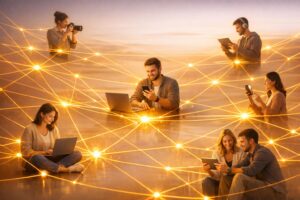Last Updated on July 1, 2025 by Becky Halls
Whether you’re a business owner, a marketing expert, a coach, or just getting into content creation, writing a blog post can feel a bit overwhelming. What do you write about? How do you know how much to write and how to structure it? And finally, how do you actually get people to read it?
Good news: you don’t need to reinvent the wheel. There are tried-and-tested formats that work across industries. We decided to collate the best blog post examples we could find, to cover a variety of industries, and give you practical tips on what to include. We’ll walk through simple steps to make sure your post gets seen (and clicked).
Why Blog Posts Still Matter
In 2025, blog posts are far from dead. In fact, they’re one of the best ways to:
- Boost organic traffic
- Build trust with your audience
- Share expertise and insights
- Support SEO strategies
I’m sure we’ve all come across blog posts and have seen the huge variety in content in user experience. That’s where knowing the right format, and optimizing it, makes all the difference.
Our Blog Post Examples That Work (Across Industries)
Here are popular blog post examples you can use no matter your niche, along with what makes each one effective and how to get the most out of them:
1. How-To Guides
Perfect for: Coaches, SaaS, eCommerce, fitness trainers, consultants
What it should include:
- A clear, step-by-step process
- Real-life examples or screenshots
- A clear benefit and conclusion for the reader
Key points to remember:
- Be detailed and show your own knowledge and point of view
- Use headers and bullet points to make each step easy to follow
- Include visuals or links to tools/resources
What makes it effective: How-to guides are practical and problem-solving. They’re highly searchable and position you as a go-to expert in your field.
Example: How to Start a Podcast on a Budget
2. List Posts (a.k.a. Listicles)
Perfect for: Lifestyle brands, marketers, creatives
What it should include:
- A numbered list of tips, tools, or ideas
- Concise explanations for each item – but keep it structured
- A consistent theme or purpose
Key points to remember:
- Prioritize clarity, structure and readability
- Use bolding or subheadings to make skimming easy
- End with a takeaway or call-to-action, ensuring you’ve answered the questions users would most likely be asking
What makes it effective: Listicles are fun, fast to read, and naturally optimized for engagement. Great for social sharing and capturing short attention spans.
Example: 10 Easy Meal Prep Hacks for Busy Professionals
3. Case Studies
Perfect for: Agencies, consultants, B2B brands
What it should include:
- Background on the client or project
- The challenge or goal
- The solution you implemented
- The results (with data)
Key points to remember:
- Focus on results and transformation
- Include direct quotes or visuals if possible
- Keep it concise and focused on value delivered
What makes it effective: Case studies build credibility through storytelling and proof. They show, not just tell, your expertise and impact.
Example: How We Increased a Client’s Traffic by 210% in 3 Months
4. Beginner’s Guides
Perfect for: Any industry with complex topics
What it should include:
- Simple explanations of key terms
- A logical structure from A to Z
- Links to deeper or related resources
Key points to remember:
- Assume zero prior knowledge
- Use analogies or real-world comparisons
- Keep the tone friendly and approachable
What makes it effective: Beginner’s guides are gateway content. They attract first-time visitors and position your brand as helpful and accessible.
Example: SEO for Beginners: A Friendly Guide to Ranking Higher
5. Opinion or Thought Leadership Pieces
Perfect for: Founders, influencers, industry experts
What it should include:
- A strong point of view
- Industry trends or insights (using links to back these up)
- Personal experience or data to back it up
Key points to remember:
- Be bold but respectful
- Support opinions with logic or evidence
- Encourage discussion or debate
What makes it effective: These posts establish authority and spark engagement. They show off your unique voice and thought process, not just your knowledge.
Example: Why Authenticity Is the Future of Digital Marketing
6. Product or Service Spotlights
Perfect for: eCommerce, tech, SaaS, local businesses
What it should include:
- Background on the product or service
- Unique features or benefits
- Customer testimonials or use cases
Key points to remember:
- Make it feel like a story, not a sales pitch
- Highlight value for the user
- Use visuals to demonstrate features
What makes it effective: Spotlights are great for connecting emotionally with your audience. They humanize your brand and add depth beyond the product page.
Example: Behind the Build: How We Designed Our Eco-Friendly Yoga Mat
7. Roundups or Resources
Perfect for: Bloggers, publishers, education brands
What it should include:
- A curated list of tools, articles, or influencers
- A short summary or commentary on each item
- Links or sources for further reading
Key points to remember:
- Be selective: quality > quantity
- Keep it updated if possible
- Categorize or tag items for easier navigation
What makes it effective: Roundups save your audience time. They position your brand as a resource hub and often attract backlinks for being shareable and helpful.
Example: 15 Free Tools Every Graphic Designer Should Try
These blog post examples work because they’re reader-focused and structured to meet a specific goal – whether it’s educating, inspiring, or converting.
What to Include in Every Great Blog Post
No matter which of the blog post examples you choose, your content should check a few key boxes:
- Strong headline: Clear, curiosity-driven, and includes your main keyword
- Intro that hooks: Explain what readers will learn and why it matters
- Scannable structure: Use subheadings, bullet points, short paragraphs
- Visuals: Add images, infographics, or videos to break up text
- Internal links: Guide readers to other helpful posts on your site
- CTA (Call to Action): Tell readers what to do next – subscribe, comment, book a call, etc.
Pro Tip: Write like you’re talking to a real person. Keep it clear, conversational, and helpful.
How to Get More Eyes on Your Blog Post
Creating amazing content is step one. But if no one sees it, you’re missing the mark. Here’s how to make sure your blog post gets the attention it deserves:
1. SEO Optimize It
- Use your primary keyword (like “blog post examples”) in your title, headers, meta description, and body
- Add alt text to images
- Include related keywords and synonyms naturally
2. Share on Social Media
- Repurpose key points into carousels or reels
- Create quote graphics or infographics
- Tag relevant people or brands mentioned in your post
3. Send It to Your Email List
- Add a short teaser with a link to your post
- Use a strong subject line like “Need Blog Ideas? We’ve Got 7 You Can Steal”
4. Build Backlinks
- Share in relevant communities or forums
- Submit guest posts that link back to your article
- Use a backlink exchange platform like 3Way.Social to get ethical, niche-relevant links
Final Thoughts: Blog Smarter, Not Harder
There’s no shortage of blog post examples out there, but the key is choosing formats that serve your audience, match your brand voice, and align with your goals.
Write content that solves problems. Make it easy to read and even easier to share. And above all, stay consistent.
You don’t need to be a copywriting wizard to write a great blog post. With the right structure, some optimization, and a little bit of personality, you’ll be well on your way to creating content that gets seen and remembered.
FAQs: Blog Post Examples & Best Practices
What type of blog post gets the most traffic?
How-to guides and listicles tend to perform best in search engines because they solve problems quickly and are easy to skim. Pair them with good SEO and promotion for maximum reach.
How long should a blog post be in 2025?
While there’s no perfect number, most high-ranking blog posts are between 1,000–2,000 words. The key is quality and structure—make sure your content answers the reader’s query thoroughly.
What’s the best blog format for beginners?
Start with list posts or how-to guides. They’re easy to structure, engaging for readers, and naturally optimized for keywords and headings.
How do I get people to actually read my blog post?
Hook them with a strong intro, break up your content with visuals and subheadings, and make sure your post is mobile-friendly. Then promote it across channels: email, social, and backlink platforms like 3way.social.
Can I reuse blog formats across different industries?
Absolutely. Most of the blog post examples in this article work across industries. Just tailor the language, examples, and tone to match your audience.
Do blog posts still help with SEO in 2025?
Yes, and arguably more than ever. With the right keywords, structure, and backlinks, blog posts remain one of the most effective ways to drive organic traffic and build authority.






